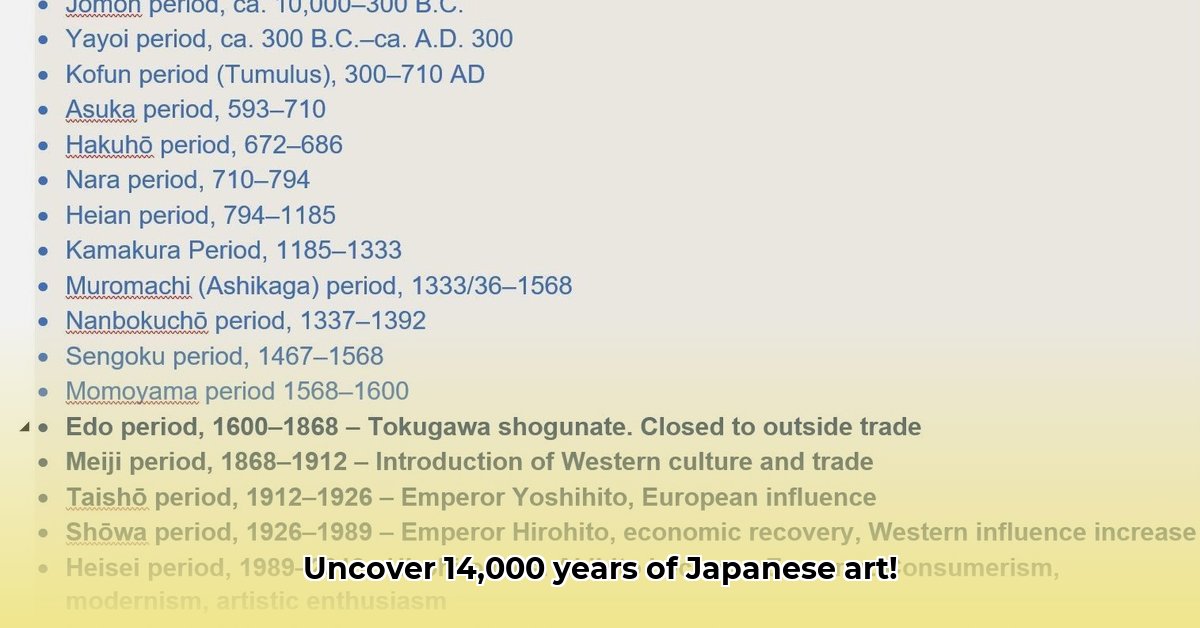
Japanese Art: A 14,000-Year Journey
Embark on a captivating journey through 14,000 years of Japanese art, uncovering the stories woven into pottery, paintings, and sculptures. These artistic expressions reflect the evolving lives and beliefs of the Japanese people, a narrative as rich and layered as the art itself. Prepare to be amazed! For more on individual artists, check out this helpful resource: Japanese Artists.
Prehistory: Jōmon, Yayoi, and the Dawn of Artistic Expression
Our adventure begins in prehistory, a time when the very concept of "Japan" was nascent. The Jōmon period (c. 14,000-1000 BCE) unveils the earliest evidence of artistic expression in Japan. Imagine hunter-gatherer societies, deeply connected to the land and sea. Their art, primarily exquisite pottery, transcended mere function; it became storytelling. These aren’t simply utilitarian vessels; they're adorned with intricate patterns, hinting at a rich spiritual life and keen observation of the natural world. Experts suggest these designs represent spirits, plants, and more—a window into their cosmology. Isn't it remarkable that these ancient pieces still resonate with us today? How did such complex designs emerge from a seemingly simple way of life?
The Yayoi period (300 BCE – 300 CE) marks a pivotal shift. The introduction of rice cultivation led to settled communities, new technologies (like metalworking), and a transformation in artistic styles. We see meticulously crafted bronze mirrors and tools, reflecting a more structured society. While pottery persisted, its style evolved, becoming more refined, reflecting the impact of this agricultural revolution. What factors drove these stylistic changes? Ongoing research continues to illuminate this fascinating period.
The Kofun period (300-538 CE) brings monumental change. Enormous burial mounds, kofun (some keyhole-shaped), dominate the landscape. These aren't simply graves; they're powerful statements of power and prestige, revealing the growth of social hierarchies and advanced engineering. Inside, haniwa (clay figurines) depicting people, animals, and houses offer further insight. What stories do these enigmatic figures tell? Archaeological discoveries continue to unravel the secrets embedded within these ancient sites.
Classical Japan: Buddhism's Arrival and the Elegance of the Heian Court
The arrival of Buddhism in the 6th century (Asuka period, 538-710 CE) profoundly impacted Japan, including its artistic landscape. Visualize awe-inspiring temples, grand and vibrant, filled with breathtaking sculptures and murals depicting Buddhist narratives and figures. This wasn't merely a religious shift; it was a complete cultural transformation. Art served both to disseminate Buddhist teachings and to demonstrate the power of the ruling class. How did this fusion of indigenous and foreign aesthetics reshape Japanese artistic sensibilities?
The Nara period (710-794 CE) witnessed the creation of grand cities like Heijōkyō—a meticulously planned capital, itself a work of art. The architecture, layouts, and city design reflect a centralized government and a thriving culture. The grandeur of Nara’s art mirrors the power and ambition of this era. What innovations were driven by this ambition to build a symbolic capital city?
The Heian period (794-1185 CE) is renowned for its refined aristocratic culture. Its art epitomizes elegance, featuring delicate calligraphy, exquisite yamato-e paintings (depicting Japanese subjects and scenes), and the emergence of early novels like The Tale of Genji. This aesthetic mirrors the elegant lifestyle of the imperial court. What aspects of Heian court life are revealed in its art?
Medieval Japan: Samurai, Zen, and the Beauty of Imperfection
Medieval Japan (Kamakura, 1185-1333 CE; Muromachi, 1336-1573 CE; and Azuchi-Momoyama, 1573-1603 CE periods) saw a shift in power with the rise of the samurai class. However, it wasn’t a complete departure from the past. Consider the powerful and expressive Buddhist sculptures of Unkei, a testament to the seamless blending of traditional techniques and spiritual intensity. Remember the influence of Zen Buddhism, with its emphasis on simplicity and meditation, which is clearly reflected in the aesthetics of this time. The wabi-sabi aesthetic, appreciating imperfection and impermanence, emerged as a core philosophy, influencing everything from tea ceremonies to painting. Does this embrace of imperfection reflect a reaction to the turbulent times?
The Edo Period: Artistic Flourishing in Isolation
The Edo period (1603-1868 CE), a time of relative isolation, witnessed a unique artistic explosion. Without significant foreign influence, Japanese artists developed distinctive styles. Woodblock prints (ukiyo-e) became incredibly popular, appealing to a wider audience than previous artistic forms. These prints captured the beauty of everyday life—landscapes, people, and stories from popular theatre. Think of Hokusai's iconic Great Wave off Kanagawa; it exemplifies the creativity and accessibility of art in this period. How did this period of isolation shape the unique artistic style of the Edo era?
A Quick Look at Japanese Art Through Time (Summary Table)
| Period | Dates | Key Characteristics | Artistic Highlights |
|---|---|---|---|
| Jōmon | 14,000-1000 BCE | Earliest pottery; hunter-gatherer life | Intricate pottery designs |
| Yayoi | 300 BCE-300 CE | Rice farming; metalworking; social changes | Bronze tools and mirrors; evolving pottery styles |
| Kofun | 300-538 CE | Huge burial mounds; advanced metalwork | Keyhole-shaped mounds; haniwa clay figures |
| Asuka | 538-710 CE | Buddhism arrives; temple building | Buddhist sculptures and murals |
| Nara | 710-794 CE | Planned capital city; flourishing Buddhist art | Grand Buddhist temples and sculptures |
| Heian | 794-1185 CE | Refined aristocratic culture; elegant art | Yamato-e paintings; graceful calligraphy |
| Kamakura | 1185-1333 CE | Rise of samurai; Zen Buddhism's influence | Powerful Buddhist sculptures; Zen painting styles |
| Muromachi | 1336-1573 CE | Zen influence; tea ceremony; ink painting; | Ink wash painting (sumi-e); refined aesthetics |
| Azuchi-Momoyama | 1573-1603 CE | Unification; lavish artistic styles | Ornate screens; gold leaf techniques |
| Edo | 1603-1868 CE | Isolation; ukiyo-e; diverse artistic patronage | Woodblock prints (ukiyo-e); popular art forms |
This journey through time offers just a glimpse into the vast world of Japanese art history. Each period holds countless stories awaiting discovery. Continue your exploration—the rich artistic heritage of Japan is as astonishing as it is diverse!